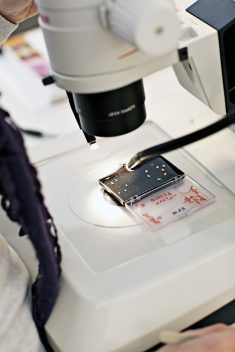Research track multiplies proportion of researchers
Only a small percentage of medical students become full-time researchers. But university research tracks have increased the proportion of doctoral degrees taken tenfold.
Most medical students choose to practice medicine after graduation. Few choose a career exclusively as researchers.
The trend in the proportion of doctors who want to do research has been declining for several decades and has resulted in a recruitment problem.
But a Medical Student Research Programme (MSRP) option that has been built into Norwegian medical curricula shows a different picture.
“The research programme yields ten times as many physicians who complete a PhD than medical schools that do not offer this option,” says Professor Emeritus Geir Wenberg Jacobsen, author of an article now being published in PLOS ONE.
In addition, a much larger proportion of former students who opted for the research track aspire to an academic career after graduation. And about twice as large a proportion of these previous students consider a possible career in research.
Article continues under photo.

The MSRP resulted in ten times more medical doctors who pursued a PhD than medical studies without this type of offering. Illustration photo: Geir Mogen, NTNU
Publishing more research
The MSRP took effect in 2002. The programme faced no lack of criticism from those who felt such an option was unnecessary, since physicians were expected to do research anyway and those who wanted to pursue a PhD would do it regardless of the extra offering.
Seven years later, in 2009, a report concluded that although the programme had increased the proportion of doctors who became researchers, the data was inadequate to gauge the outlook going forward. Now such data have become available.

During the first 8 years after completion of their studies, 39 percent of those who completed the MSRP had also completed a PhD, in comparison to just four per cent of those MDs who graduated without such an offering. Illustration photo: Geir Mogen, NTNU
The article in PLOS ONE is based on the survey responses of 538 former medical students. Of these, 221 had taken the MSRP option and the rest made up a representative control group. During the first eight years following students’ graduation as MDs (from 2006-2014), 39 per cent of the MSRP students had completed a PhD as compared with four per cent of the traditional medical students.
Among students who had not yet completed a PhD, about half of those with an MSRP background were were in the process of obtaining on. By contrast, about 12 per cent of the other students were pursuing a doctorate.
The MSRP students had published more research and been abroad to study for a period of at least three months at twice the rate of the control group. The researchers behind the article in PLOS ONE found no gender differences.
- You might also like: Is early detection of disease always an advantage?
Head start as researchers
Clearly, some students opting for the research track may have already had their sights on an academic career. It can be argued that these students would have chosen an academic career regardless, perhaps with equally good results.
Nevertheless, the article concludes that a specialized research track can provide additional benefits, since students gain several years head start as active researchers.
Other factors may also be involved. The MSRP reduces the time it takes for students to complete a doctorate, since their supervisor from the research programme usually follows them while they work on their PhD.
The price these students pay is that they spend about one and a half years longer specializing in a medical field. “From the perspective of a 40-year career, that’s not very long,” says Jacobsen.
- You might also like: Research’s heart problems uncover security gap
Applicable to other fields of study
The results show how effective a targeted programme can be when introduced to undergraduate university students early on. The MSRP can also provide a model for other fields of study across Europe, according to the article. Jacobsen says efforts are now being undertaken to create research programmes in faculties other than medicine.
Gunnar Bovim, NTNU’s rector, is among those working to develop new research programmes. He was one of four deans who initiated the medical study research programmes in Trondheim, Bergen, Oslo and Tromsø in 2002.
“The research programme was a response to the fact that research activity among physicians had decreased. This study option has helped to reverse that trend. It shows that connecting intelligent students to research environments is working. Students achieve a much higher level of competence than if they did the study programmes sequentially. Both Norwegian and international experience show that this approach works. We believe it will be equally effective in other fields of study,” says Bovim.
Another prime mover for the establishment of a research track in medicine was John-Arne Røttingen, current Director General of the Research Council of Norway. The Research Council and Norway’s Ministry of Education have been involved and secured funding since the start. The editor of PLOS ONE has also praised the article because of its national profile, the use of a relevant control group, and because it can be followed up with regard to further long-term effects.
Source: Springboard to an Academic Career – A National Medical Student Research Program. Geir W. Jacobsen, Helge Ræder, Marianne H. Stien, Louis A. Munthe, Vegard Skogen.






